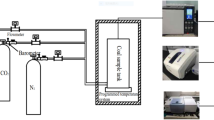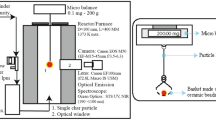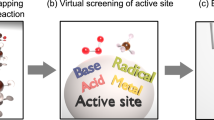Abstract
The combustion of coal and heavy oil produces significant quantities of NOx (NO + NO2), which ultimately participates in photochemical smog and acid rain. Combustion modification schemes, such as staged combustion1 and reburning2, or downstream injection of selective reducing agents, particularlarly ammonia3 and urea4, can significantly reduce NOx emissions, but their effectiveness may be limited by operating constraints. Perry and Siebers5 described a selective reduction process using cyanuric acid, reported to be effective over a broad temperature range. Here we report new data that indicate that the same reductions can be achieved without stainless steel to activate the reaction mechanism, if the process is combined with reburning or staged combustion (or slightly fuel-rich operation in internal combustion) to produce carefully controlled stoichiometry. The NOx reductions that can be achieved with cyanuric acid and other –NH- and –CN-containing compounds at relatively low temperatures exceed those possible with either combustion modifications or selective reduction techniques alone or in normal combination.
This is a preview of subscription content, access via your institution
Access options
Subscribe to this journal
Receive 51 print issues and online access
$199.00 per year
only $3.90 per issue
Buy this article
- Purchase on Springer Link
- Instant access to full article PDF
Prices may be subject to local taxes which are calculated during checkout
Similar content being viewed by others
References
Wendt, J. O. L., Pcrshing, D. W., Lee, J. W. & Glass, J. W. 17th Int. Symp. (Combustion Institute, 1979).
Chen, S. L. et al. 21st Int. Symp. (Combustion Institute, 1987).
Lyon, R. K. Hydrocarbon Processing 58, 10 (1979).
Arand, J. K., Muzio, L. J. & Sottic, J. G. US Patent No. 4,208,386 (1980).
Perry, R. A. & Siebers, D. L. Nature 324, 657–658 (1986).
Bowman, C. T. 14th Int. Symp. (Combustion Institute, 1973).
Chen, S. L., Heap, M. P., Pershing, D. W. & Martin, G. B. 19th Int. Symp. (Combustion Institute, 1982).
England, G. C., Heap, M. P., Pershing, D. W., Nihart, R. K. & Martin, G. B. 18th Int.Symp. (Combustion Institute, 1981).
Brogan, T. R. US Patent 4,335,084 (1982).
Arand, J. K. US Patent 4,325,924 (1982).
Chen, S. L. et al. 22nd Int. Symp. (Combustion Institute, 1988).
Author information
Authors and Affiliations
Rights and permissions
About this article
Cite this article
Heap, M., Chen, S., Kramlich, J. et al. An advanced selective reduction process for NOx control. Nature 335, 620–622 (1988). https://doi.org/10.1038/335620a0
Received:
Accepted:
Issue Date:
DOI: https://doi.org/10.1038/335620a0
This article is cited by
Comments
By submitting a comment you agree to abide by our Terms and Community Guidelines. If you find something abusive or that does not comply with our terms or guidelines please flag it as inappropriate.



